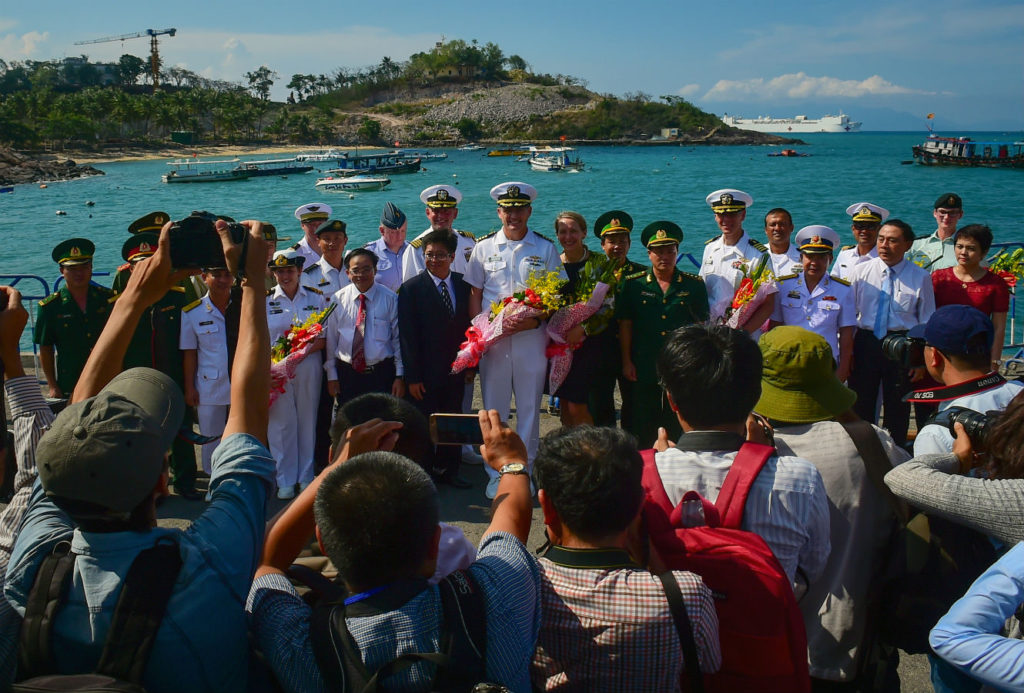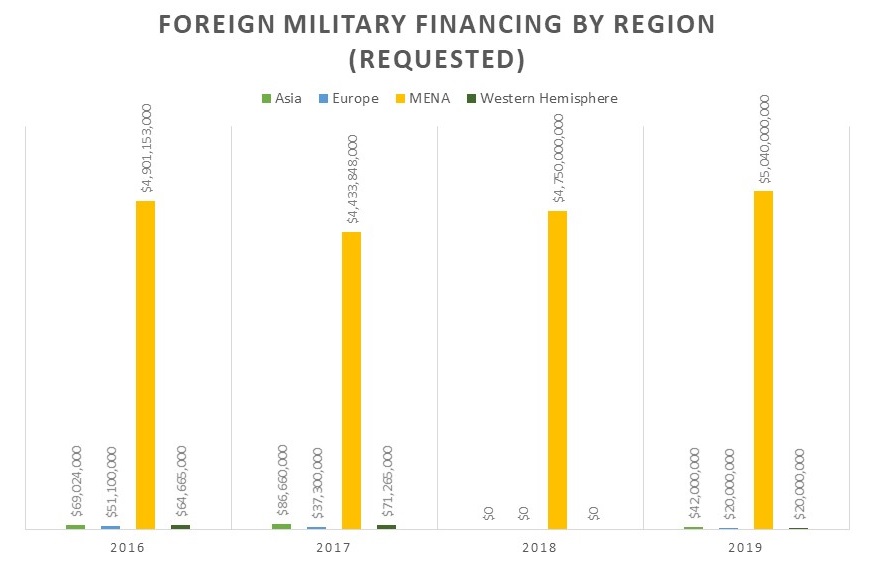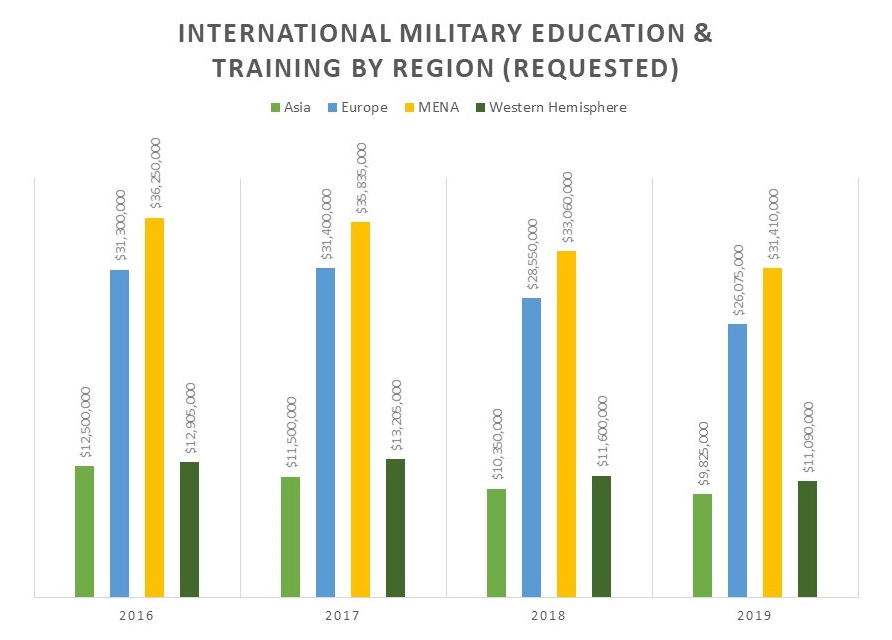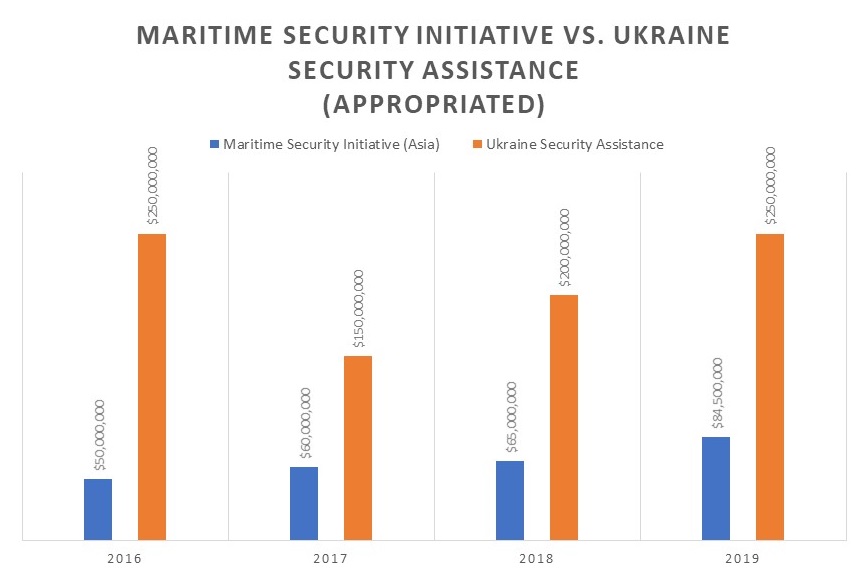Assessing America’s Indo-Pacific Budget Shortfall

Budgets are policy in Washington. Setting new trends in Pentagon and State Department funding is a tall order, so when they do emerge, they are the strongest indication of a growing consensus within an administration and Congress of shifting foreign policy priorities. Witness the Reagan defense buildup of the 1980s, the post-Cold War “peace dividend” drawdown in the 1990s, the post-9/11 defense buildup from 2001 to 2009, and the more-recent (but still unrealized) emphasis on high-end warfare and offset strategies.
Now, let’s turn to the Indo-Pacific. Beginning in 2011, the Obama administration talked about rebalancing America’s time, energy, and resources to Asia. The Trump administration followed suit and released two strategy documents that made their priorities absolutely clear. Yet today there is a large and persistent gap between the level of importance the U.S. government has attached to the Indo-Pacific and what annual appropriations continue to prioritize at the State Department and Pentagon. A bipartisan consensus has emerged to the extent that major foreign policy speeches and strategy documents now conclude that the Indo-Pacific is the central organizing principle for the U.S. government, but you would not know it by reading the last two administrations’ budget submissions. If budgets are truly policy, the administration and Congress have a long way to go. However, there is an opportunity to align budgets with strategy pronouncements in the upcoming Fiscal Year 2020 submission, the first submission to be built entirely after the release of the new National Security Strategy and National Defense Strategy.
The prioritization of the Indo-Pacific in State Department funding is not a new dilemma, nor does the blame fall only on the executive branch. Take 2017, for example. After the Trump administration had proposed cutting foreign military financing grants to replace it with a loan program, Congress rejected the proposal and restored many of the cuts in the final consolidated appropriations act. However, while significant funds were added back for countries like Ukraine and Jordan, in a move that went largely unnoticed, the final appropriations bill restored almost no funding for the Indo-Pacific. Despite emerging leadership on the region in Congress, this event was a stark reminder of the limited consideration that the region receives compared to other pressing interests in Europe and the Middle East.
The shortfall becomes more pronounced when one digs a layer deeper into the State Department budget. ‘Foreign Military Financing’ (FMF) is a security assistance mechanism the State Department uses to build the military capacity of front-line ally and partner states. This year’s State Department budget request asked for over $5 billion in FMF, but only $42 million for East Asia and the Pacific ($30 million for the Philippines and $12 million for Vietnam). That means that the entire East Asia and the Pacific region was slated for less than 1 percent of the State Department’s total FMF budget. It should be noted that this is a persistent problem that existed in the Obama years as well. However, it is also true that under the current administration the levels of requested funding for the region have fallen even further, and previous recipients such as Indonesia and Mongolia are no longer being identified for FMF funds. At the same time, the administration requested $1.3 billion for Egypt, $350 million for Jordan, and $50 million for Lebanon. Even the request for Tunisia was $40 million, roughly the same level of funding as all FMF for East Asia and the Pacific combined.

Foggy Bottom also spends roughly $100 million each year on international military education and training, a key tool to help educate and build lasting relationships with military officers from foreign countries. While the administration requested $26.1 million for Europe and Eurasia and $15.1 million for the Middle East this year, it only requested $9.8 million for East Asia and the Pacific and $11.1 million for South and Central Asia (including Afghanistan). That means that East Asia and the Pacific is slated to receive just 37 percent of the military education funding that is planned for Europe and Eurasia and 64 percent of the planned total for the Middle East. Even Western Hemisphere states were slated to receive more ($11 million) than East Asia and the Pacific. Finally, Jordan and Lebanon alone were scheduled to receive as much ($6.5 million) as Vietnam, Mongolia, Sri Lanka, Malaysia, and Indonesia combined.

At the Pentagon, the picture is just as concerning. Just as the Obama administration began discussing a rebalance to Asia in 2011, sequestration caps became law and additional resources never showed up at the Department of Defense. While the Defense Department can claim that new platforms like destroyers, submarines, and fighters are heading to the region, the operational gap with China has grown in ways that shiny platforms alone will not address. Indo-Pacific Command, among other needs, requires new investments for complex joint exercises, construction of new operating locations across the theater to allow the Air Force to operate in a more expeditionary fashion and avoid targeting by China’s Rocket Forces, and a new generation of high-end munitions.
The military services are always eager to build new platforms but more reluctant to expend their limited resources on areas that matter operationally to a long-term competition, including new posture initiatives, deployments, prepositioned equipment, and munitions. For now, Indo-Pacific Command has been left to make minor budget adjustments to address a considerable operational problem across a huge geographic space. Juxtapose that with European Command, where billions of dollars have been earmarked each year to address similar shortfalls.
Despite sequestration cuts, following the Russian annexation of Crimea in 2014, the Defense Department moved swiftly to address the growing operational shortfalls that had emerged in Europe by announcing a European Reassurance Initiative (since renamed the European Deterrence Initiative). This injected European Command with considerable new resources for exercises, new deployments, critical military infrastructure, propositioned equipment, and security assistance funds. In five years, the fund has grown from several hundred million dollars to a request of $6.5 billion this year alone. When Indo-Pacific Command raised the idea of a similar reassurance initiative for Asia in 2017, it was dismissed. Instead, the command must continue to rely on the military services, which command most of the budget, to address its vast shortfalls as part of the normal budget process where no additional resources are earmarked for Asia.
We can find similarly lopsided spending when comparing Pentagon security assistance for the Indo-Pacific with support for Ukraine. The Ukraine Security Assistance Initiative, a Defense Department effort to provide military equipment and training to the Ukrainian military, grew to $150 million last year. This year, the department requested $200 million and the final defense appropriations bill increased it even higher to $250 million, indicating strong bipartisan support for countering Russia’s aggression in Ukraine. But what about Asia? The emergence of the Maritime Security Initiative in 2015 represented a bipartisan effort to build the capacity of maritime states in Southeast Asia facing Chinese coercion. This effort was designed to focus not a single country but on a regional effort that included the Philippines (a U.S. treaty ally, unlike Ukraine), Vietnam, Indonesia, and Malaysia. It began modestly at $50 million and grew to a request of $98 million in this year’s defense budget. Congress was expected to support this funding level — less than half of what was requested for Ukrainian assistance — given the bipartisan interest in the region. However, the House appropriations subcommittee actually moved to cut the request by $48 million, while the Senate cut it by some $13.7 million. Some observant members filed an amendment to restore the cut, but it ultimately did not make it into the final House bill. The final appropriations bill followed the Senate cut and only made $84 million available for the entire regional initiative — a mere third of what the United States will spend on security assistance for a single country, Ukraine. This is another example of how priorities in Europe are quickly resourced, supported, and even expanded, while similar actions in the Indo-Pacific are increased modestly and under tight budgetary scrutiny.

Despite the growing acceptance that the Indo-Pacific and U.S.-Chinese competition represents America’s most pressing long-term challenge, there remains a stark contrast between how the administration and Congress continue to budget for Asian security matters compared to other international issues. This is not to argue that other priorities, such as European Command and countering Russian in Ukraine, are not important. They are and deserve budgetary support. Some will argue that this budgetary emphasis demonstrates a bias towards those theaters at the expense of Asia. There may be some truth to this. Understanding and responding to the Russia threat as well as the terrorism challenge remains a part of America’s national security muscle memory, where support can quickly be galvanized and resources persistently applied. Significant work still needs to be done to translate the emerging understanding of America’s long-term position in the Indo-Pacific by senior leaders and congressional staff into actual shifts in budgetary priority.
To be fair, in recent years Congress, with administration support, has taken important actions in the theater, including the creation and funding of the Maritime Security Initiative in 2015, funding of the Palau Compact in 2017, resourcing some of Indo-Pacific Command’s unfunded requirements in 2018, devoting resources for dioxin remediation in Vietnam, and reorganizing and raising the lending limit for the Overseas Private Investment Corporation as part of the BUILD Act. But the issue remains that the scale of resource commitment to the region continues to fall short of the sizable objectives the U.S. government has set for itself.
In an attempt to remedy the continued shortfall, bipartisan legislation emerged earlier this year in both the Senate and House. The Asia Reassurance Initiative Act of 2018, modeled off of an idea by the late Sen. John S. McCain, authorizes the Pentagon and State Department $1.5 billion for each of the fiscal years 2019 through 2023 to “advance United States foreign policy interests and objectives in the Indo-Pacific region.” The Senate may consider the legislation soon. While just an authorization bill, its real impact can be measured in the growing interest it generated for the State Foreign Operations appropriations subcommittee to increase funding for the region in this year’s bill. Chairman Lindsey Graham was able to recommend an additional $160 million in his bill for implementation of an Indo-Pacific Strategy. However, it remains unclear how much of this increase will hold up in the final conference process and much of the increase, while commendable, went to development assistance and economic support rather than security capacity assistance.
Which brings us to next year’s budget and why 2020 — the first Trump administration budget fully informed by the National Security Strategy and National Defense Strategy — will be such an important opportunity for change. While we cannot expect the proverbial aircraft carrier that is government bureaucracy to shift a full 90 degrees, we should watch closely for the Pentagon and State Department to begin a real shift of budget priorities away from traditional areas of investment and towards the Indo-Pacific. At a basic level, this would mean a State Department budget that leads with what it is doing in Asia as a core strategic objective. Last year’s budget request fact sheet had no mention of the Indo-Pacific, despite the recent release of the National Security Strategy. We should also watch how the State Department plans to resource Secretary Pompeo’s long-term vision, laid out in his Indo-Pacific Business Forum speech from July 2018. Finally, despite budgets not increasing, State and congressional appropriations should be willing to execute the difficult task of shifting resources from other regions to prioritize FMF, military education and training, and other aid for South and Southeast Asia. Over at the Pentagon, the same operational holes that defense budgets have been filling in European Command for the last five years have to be addressed with urgency in the Pacific. Billions will be required each year. But if the National Defense Strategy has made the military balance with China the first priority of the Department, it should be a realistic task for Pentagon leadership to identify those resources as part of a $700 billion budget. A similar Indo-Pacific Deterrence Initiative is required for Asia.
Continuing to give other functional issues and regional challenges budgetary priority will not bring about the shift in national foreign policy emphasis that the United States has set for itself. As Washington’s mental map of the Indo-Pacific matures, the next step in implementing this new consensus on China will fall to the administration, elected officials, and senior congressional staff to prioritize resource levels for the region commensurate with the great power competition we find ourselves in.
Eric Sayers is an Adjunct Senior Fellow at the Center for a New American Security (CNAS). He previously worked as a Professional Staff Member on the Senate Armed Services Committee and as a consultant to U.S. Pacific Command, where he worked as Special Assistant to the Commander.
Image: Mass Communication Specialist 1st Class Micah Blechner

